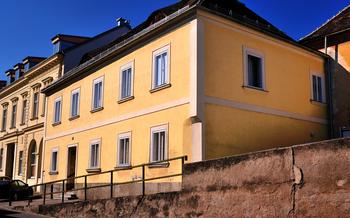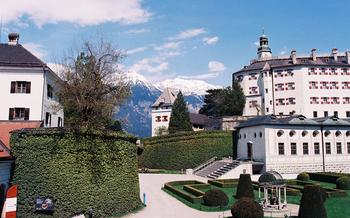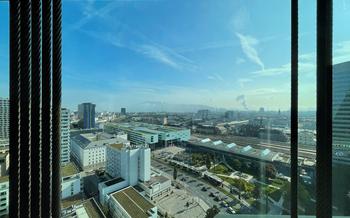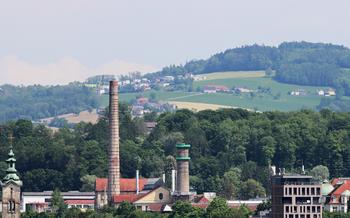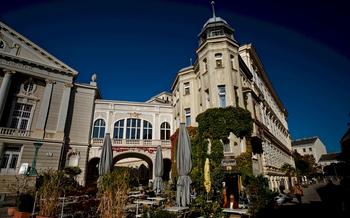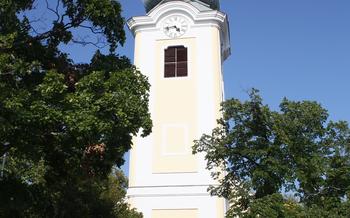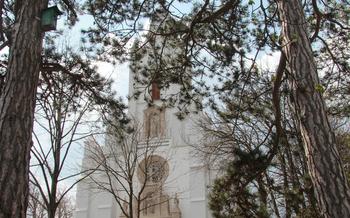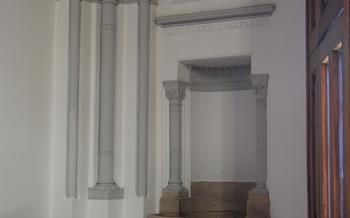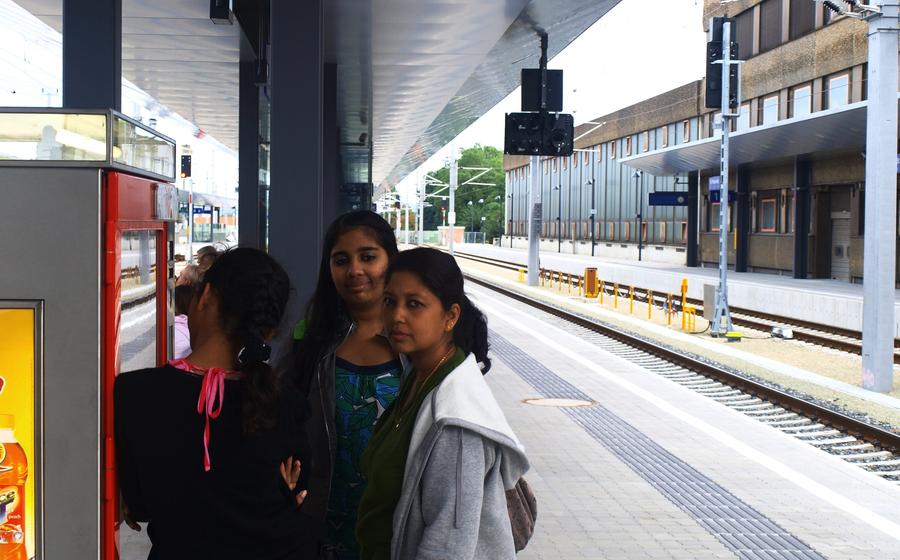
Lilienfeld Abbey
- History of Lilienfeld Abbey
- Architectural Highlights
- The Abbey's Interior
- Monastic Life and Traditions
- Museum and Exhibitions
- Abbey Grounds and Gardens
- Cultural Events and Concerts
- Abbey Shop and Local Products
- Guided Tours and Accessibility
- Pilgrimage and Spiritual Retreats
- Surrounding Attractions
- Practical Information
- Accommodations and Dining
- Local Festivals and Events
- Insider Tip: Unveiling the Secret Garden
History of Lilienfeld Abbey
Nestled amidst the scenic landscapes of Lower Austria, Lilienfeld Abbey stands as a testament to the region's rich religious and architectural heritage. Its origins can be traced back to the 12th century when Margrave Leopold III of Austria, driven by a desire for spiritual renewal, founded the abbey in 113The Cistercian order, known for its strict adherence to the Benedictine Rule, was entrusted with the task of establishing a monastic community at Lilienfeld. Under the guidance of their first abbot, Ulrich, the Cistercians transformed the abbey into a thriving religious and cultural center, leaving an indelible mark on the region's history.
Over the centuries, Lilienfeld Abbey underwent several architectural transformations, blending Romanesque and Gothic influences into a harmonious ensemble. The abbey church, a prime example of Cistercian design, stands as a testament to the order's architectural prowess. Its vaulted ceilings, ribbed arches, and intricate stonework create a sense of awe and reverence, reflecting the Cistercians' dedication to simplicity and functionality. The cloisters, with their serene ambiance and decorative elements, provide a tranquil space for contemplation and reflection.
Architectural Highlights
The architectural grandeur of Lilienfeld Abbey is a testament to the skill and artistry of the Cistercian monks. Romanesque and Gothic influences blend harmoniously, creating a visually stunning ensemble. The abbey church, the centerpiece of the complex, epitomizes Cistercian design with its simple yet elegant lines. Vaulted ceilings soar overhead, supported by intricately ribbed arches, while intricate stonework adorns the walls and pillars, showcasing the monks' meticulous craftsmanship.
The cloisters, a tranquil oasis within the abbey's bustling grounds, invite visitors to wander and reflect. Arcades of slender columns frame serene courtyards, creating a sense of peace and serenity. Decorative elements, such as carved capitals and delicate tracery, add a touch of grace to these sheltered walkways.
Stepping inside the abbey church, visitors are greeted by a symphony of light and color. Stained glass windows, crafted with exquisite artistry, depict biblical scenes and historical events, casting a warm glow on the interior. Frescoes and murals adorn the walls and ceilings, narrating stories from the Bible and the abbey's history, inviting visitors to contemplate their spiritual significance.
Another highlight of the abbey's interior is the grand organ, a masterpiece of craftsmanship and artistry. Intricate carvings embellish its wooden case, while its powerful sound fills the church with rich, resonant tones. The organ's acoustics, carefully engineered by the Cistercian monks, create an immersive experience that transports listeners to another realm.
The Abbey's Interior
The interior of Lilienfeld Abbey is a testament to the artistic and spiritual devotion of the Cistercian monks. The abbey church, the heart of the monastery, boasts a breathtaking display of ornate altars and sculptures. The high altar, a masterpiece of Baroque artistry, features intricate carvings, gleaming gold leaf, and a radiant depiction of the Assumption of Mary. Throughout the church, numerous side altars showcase exquisite craftsmanship, each dedicated to a different saint or biblical figure.
The abbey's stained glass windows, with their vibrant hues and intricate designs, add to the interior's ethereal ambiance. These windows depict scenes from the Bible, historical events, and the lives of saints, casting a colorful glow on the abbey's sacred space. The windows serve as a visual narrative, guiding visitors through the stories of faith and devotion that shaped the abbey's history.
The walls and ceilings of the abbey are adorned with frescoes and murals, adding a layer of artistic splendor to the interior. These paintings depict biblical scenes, allegorical representations, and the daily life of the monks, offering a glimpse into the spiritual and intellectual world of the Cistercians. The grand organ, with its intricate carvings and impressive acoustics, completes the abbey's interior symphony. Its majestic sound resonates through the church, creating an atmosphere of awe and inspiration that enhances the spiritual experience of visitors.
Monastic Life and Traditions
The Cistercian monks of Lilienfeld Abbey live according to the strictures of the Benedictine Rule, a set of principles that emphasize prayer, work, and contemplation. Their daily routine begins at 5:30 am with prayers and continues with a cycle of manual labor, study, and worship throughout the day. The monks follow a strict vow of silence, broken only for essential communication.
Central to the Cistercian way of life is the concept of ora et labora (prayer and work). The monks engage in both physical and intellectual labor, including farming, gardening, and manuscript illumination. This work is seen as a form of prayer and a means of self-sufficiency for the community.
The abbot serves as the spiritual and administrative leader of the community. He is elected by the monks and holds office for life. The abbot is responsible for maintaining discipline, providing guidance, and representing the abbey to the outside world.
Museum and Exhibitions
The abbey's museum is a treasure trove of artifacts, manuscripts, and historical documents that provide a glimpse into the rich past of Lilienfeld Abbey. Permanent and temporary exhibitions showcase the abbey's history, art, and cultural significance, offering visitors a deeper understanding of this remarkable institution. Guided tours led by knowledgeable docents provide insights into the museum's collections and the abbey's fascinating past. Interactive displays and multimedia presentations enhance the visitor experience, bringing the abbey's story to life. The museum is a must-see for anyone interested in the history, art, and culture of Austria.
Abbey Grounds and Gardens
The abbey grounds offer a tranquil retreat for visitors seeking peace and natural beauty. Stroll through the well-maintained gardens, admiring the colorful flowerbeds, manicured lawns, and tranquil ponds. Heritage trees and sculptures add to the scenic beauty of the surroundings, creating a serene and picturesque atmosphere. Take a leisurely walk, find a quiet spot for contemplation, or simply relax and enjoy the tranquility of nature. The abbey grounds are a haven of peace and tranquility, inviting visitors to escape the hustle and bustle of everyday life and immerse themselves in the beauty of the natural world.
Cultural Events and Concerts
Lilienfeld Abbey is not just a place of religious significance; it is also a vibrant cultural center that hosts a variety of events and concerts throughout the year. The abbey's impressive acoustics and stunning ambiance make it an ideal venue for musical performances, ranging from classical concerts to contemporary performances.
Regularly held events include classical music concerts featuring renowned orchestras and soloists, as well as choral singing performances by the abbey's own choir. These events offer a unique opportunity to experience the abbey's rich musical heritage and appreciate the talents of gifted musicians in an intimate setting.
In addition to classical music, the abbey also hosts contemporary performances, such as jazz concerts, theater productions, and dance recitals. These events showcase the abbey's commitment to promoting diverse artistic expressions and providing a platform for emerging artists.
The abbey's cultural offerings contribute significantly to the region's cultural landscape. By hosting these events, the abbey not only preserves its own cultural heritage but also fosters creativity and supports the local arts community. Visitors to the abbey are encouraged to check the event calendar and attend a concert or performance during their visit to experience the abbey's vibrant cultural side.
Abbey Shop and Local Products
The abbey's shop is a treasure trove of locally produced goods and souvenirs that offer a unique opportunity to take home a piece of the abbey's heritage. Visitors can browse a wide range of traditional crafts, handmade items, and regional delicacies, all carefully selected to showcase the skills and traditions of the local artisans.
From intricately carved wooden figurines and hand-painted ceramics to delicate lacework and traditional textiles, the shop offers a diverse collection of authentic Austrian crafts. Visitors can also indulge in a variety of regional delicacies, including locally produced honey, jams, and cheeses, as well as traditional sweets and pastries.
By purchasing items from the abbey shop, visitors not only support local artisans and the preservation of traditional skills but also contribute to the abbey's ongoing mission of providing spiritual guidance and support to the community. The shop provides a meaningful way to connect with the abbey's history and culture while contributing to the local economy.
Guided Tours and Accessibility
Explore the depths of Lilienfeld Abbey's rich history and cultural significance through guided tours. Knowledgeable guides lead visitors through the abbey's grand halls, revealing captivating tales of its past and shedding light on its architectural marvels. Tours are conducted in multiple languages, ensuring that visitors from all corners of the globe can delve into the abbey's captivating narrative.
For those with disabilities, Lilienfeld Abbey is committed to providing an inclusive and accessible experience. Ramps and elevators have been strategically placed throughout the abbey, allowing wheelchair users to navigate the premises with ease. Additionally, audio guides are available, offering a comprehensive tour experience for visitors with visual impairments.
Advance booking for guided tours is highly recommended, particularly during the peak tourist season. This ensures a spot on the tour and avoids any disappointment. The abbey's website provides a convenient online booking system, making it easy to secure your place.
With its commitment to accessibility and the wealth of knowledge shared by its guides, Lilienfeld Abbey welcomes visitors of all abilities to embark on a journey through time and spirituality.
Pilgrimage and Spiritual Retreats
Lilienfeld Abbey holds a significant place as a pilgrimage site, attracting visitors from diverse backgrounds seeking spiritual fulfillment and renewal. Its serene atmosphere and rich history provide an ideal setting for contemplation, reflection, and communion with the divine. For those seeking a deeper spiritual experience, the abbey offers guided retreats and programs that focus on meditation, prayer, and personal growth. The resident monks provide guidance and support to pilgrims, helping them navigate their spiritual journeys and find inner peace. Whether embarking on a solitary retreat or joining a group program, Lilienfeld Abbey offers a sanctuary for spiritual exploration and renewal, inviting visitors to connect with their inner selves and find solace in the embrace of this sacred space.
Surrounding Attractions
Explore the charming town of Lilienfeld with its historic buildings, cafes, and shops. Immerse yourself in the town's rich history and admire the well-preserved architecture that reflects its past. Take a leisurely stroll through the picturesque streets, discovering hidden gems and soaking in the local atmosphere. Indulge in delicious pastries and aromatic coffee at one of the cozy cafes, or savor traditional Austrian cuisine at a local restaurant.
Venture into the nearby Türnitzer Alps for a refreshing dose of nature and adventure. Lace up your hiking boots and embark on scenic trails that wind through lush forests, past sparkling streams, and up to breathtaking viewpoints. Marvel at the stunning panoramic vistas that unfold before you, capturing the essence of the region's natural beauty. If biking is more your style, conquer challenging mountain passes and explore the region's diverse terrain on two wheels.
Discover other cultural attractions in the region, such as museums, castles, and monasteries. Dive into the fascinating history of the region at the Lilienfeld Museum, showcasing exhibits on local history, culture, and traditions. Step back in time as you explore the ruins of Burgruine Araburg, a medieval castle perched atop a hill, offering breathtaking views of the surrounding landscape. Embark on a pilgrimage to the Melk Abbey, a Benedictine monastery renowned for its stunning Baroque architecture and its collection of medieval manuscripts.
Plan a day trip to Vienna, the vibrant capital of Austria, for a diverse cultural experience. Immerse yourself in the city's rich history, art, and music, exploring iconic landmarks such as the Hofburg Palace, the Schönbrunn Palace, and the Belvedere Museum. Stroll along the elegant boulevards, marveling at the architectural masterpieces that line the streets. Indulge in the city's renowned culinary scene, sampling traditional Viennese dishes and pastries in charming cafes and restaurants. Experience the magic of a Viennese opera or classical concert, immersing yourself in the city's vibrant cultural atmosphere.
Practical Information
Opening Hours and Admission Fees:
- The abbey is open to visitors from Tuesday to Sunday, with varying hours depending on the season.
- Regular opening hours are typically from 9:00 AM to 5:00 PM, with extended hours during peak tourist season.
- Admission fees apply, with separate charges for adults, children, and families.
- Discounts are available for groups, students, and seniors.
- Guided tours are available in multiple languages at an additional cost.
Contact Information:
- For inquiries, reservations, and guided tour bookings, contact the abbey's visitor center:
- Phone: +43 (0) 2762 52512
- Email: [email protected]
- Website: www.stift-lilienfeld.at
Planning Your Visit:
- To avoid crowds, plan your visit for weekdays or during the shoulder seasons (spring and autumn).
- Guided tours are highly recommended for a deeper understanding of the abbey's history and significance.
- Book your guided tour in advance, especially during peak season, to secure your spot.
- Allow at least two to three hours to fully explore the abbey's interior, exterior, and grounds.
Accessibility:
- The abbey is committed to inclusivity and accessibility for all visitors.
- Wheelchair-accessible ramps and elevators are available throughout the abbey, ensuring easy access for visitors with disabilities.
- Audio guides are available in multiple languages, including English, German, and French, for a self-guided tour experience.
- Visitors with special needs or disabilities are encouraged to contact the abbey in advance to arrange for any necessary assistance.
Accommodations and Dining
Lilienfeld and its surroundings offer a range of accommodation options to suit different budgets and preferences. From cozy guesthouses to comfortable hotels, there are plenty of places to choose from.
-
For a truly immersive experience, consider staying at the Abbey Guesthouse, located within the abbey grounds. This historic building provides simple yet comfortable rooms, allowing guests to soak in the abbey's serene atmosphere.
-
The town of Lilienfeld also offers several charming hotels and guesthouses, such as Hotel Restaurant Alpenblick and Gasthof Hotel Zum Goldenen Ochsen. These establishments provide a convenient base for exploring the town and the surrounding area.
-
When it comes to dining, Lilienfeld boasts a selection of restaurants serving traditional Austrian cuisine and local specialties. Gasthof Hotel Zum Goldenen Ochsen and Gasthof Kirchenwirt are popular choices for authentic Austrian dishes, while Cafe Restaurant am Kirchenplatz offers a more contemporary dining experience.
-
For those seeking vegetarian, vegan, or gluten-free options, Gasthof Kirchenwirt and Cafe Restaurant am Kirchenplatz offer a range of dishes to cater to dietary restrictions.
-
Visitors can also enjoy a unique dining experience at the abbey's historic refectory or the garden restaurant, which offers a delightful setting overlooking the abbey grounds.
Local Festivals and Events
Lilienfeld comes alive with a variety of local festivals and events throughout the year, offering visitors a chance to immerse themselves in the region's vibrant culture and festive atmosphere. These events showcase traditional Austrian customs and celebrations, providing a unique glimpse into the local way of life.
One of the highlights is the annual Lilienfeld Abbey Festival, held in the summer months. This festival transforms the abbey grounds into a lively hub of music, food, and cultural performances. Visitors can enjoy concerts by renowned musicians, savor delicious local cuisine, and witness traditional dance and theater performances. The festival is a celebration of the abbey's rich history and cultural significance, attracting visitors from near and far.
Other notable events include the Lilienfeld Christmas Market, held in December, where visitors can browse stalls selling handmade crafts, festive decorations, and traditional Austrian delicacies. The Lilienfeld Farmers' Market, held every Saturday, offers an array of fresh produce, artisanal products, and regional specialties, showcasing the bounty of the local countryside.
By participating in these local festivals and events, visitors can gain a deeper appreciation for Austrian culture and traditions. Whether it's enjoying the lively atmosphere of the Abbey Festival, browsing the stalls at the Christmas Market, or savoring local flavors at the Farmers' Market, there's something for everyone to enjoy.
Insider Tip: Unveiling the Secret Garden
Beyond the well-trodden paths of Lilienfeld Abbey lies a hidden gem, a secluded retreat known as the "Secret Garden." This enchanting spot invites visitors to immerse themselves in tranquility and embrace the abbey's serene atmosphere away from the main tourist areas.
Nestled amidst towering trees and vibrant flowerbeds, the Secret Garden exudes an air of mystery and charm. Its secluded location provides a sanctuary for contemplation and reflection, allowing visitors to connect with the abbey's spiritual essence.
Discover the garden's hidden entrance and step into a world of tranquility. Wander along winding paths, admire the colorful blooms, and let the gentle sounds of nature soothe your senses. Find a secluded bench beneath a shady tree and lose yourself in a book, or simply sit in silence, absorbing the peaceful ambiance.
The Secret Garden is a testament to the abbey's commitment to providing a haven for spiritual renewal and inner peace. Whether you seek a moment of solitude, a place to meditate, or simply a chance to appreciate the beauty of nature, this hidden gem offers a unique and unforgettable experience.
To find the Secret Garden, look for a discreet entrance near the abbey's cloisters. Follow the path that leads away from the main tourist areas and let the tranquility guide you. Embrace the opportunity to discover this hidden treasure and experience the abbey's serenity in its purest form.
